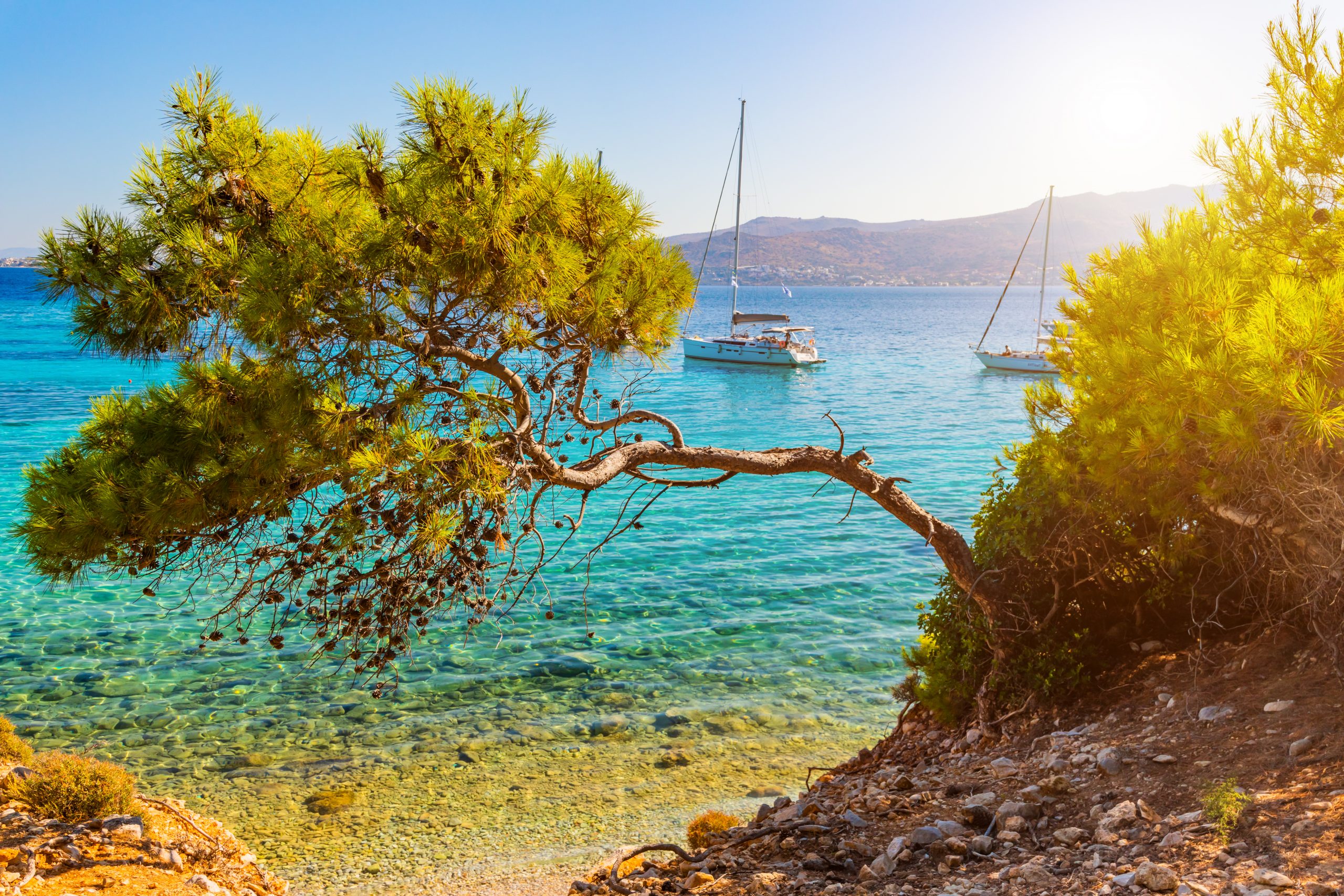Contributors: François Guerquin, Julien Le Tellier, Helena Rey and Lina Tode
The Mediterranean is an emblematic region for coastal and marine tourism, with trends and challenges reflective of the global situation. With unique landscapes and ecosystems, as well as a rich biodiversity, it offers a wide-ranging cultural and historical heritage. Its authenticity, well-connected locations, security and mild weather have made it the world’s leading tourist destination[i].
The Mediterranean covers less than 1 percent of the world’s ocean surface but is considered a biodiversity hotspot, hosting 4–18 percent of the world’s marine biodiversity, including 20–30 percent endemic species, the highest rate of endemism in the world[ii]. It could also be considered a tourism hotspot: with more than 400 million international tourist arrivals (ITAs) in 2019, the tourism sector in The Mediterranean region, accounted for up to 15 percent of regional GDP and employment[iii]. Since 1995, the sector has grown by about 75 percent and, according to the UN World Tourism Organization (UNWTO), it was expected—before the pandemic—to reach 626 million ITAs by 2025[iv].
If not well planned, this growth can harm the very assets tourists are attracted to, endangering the economic and social returns for residents and local businesses[v] and threatening its long-term sustainability[vi]. Tourism in the Mediterranean is characterised by densely occupied coastal areas, mainly during the summer season. While tourism has significantly contributed to the region’s economic development, it also has created major negative externalities, impacting the natural, cultural and social resources of countries along its shores. This situation could be exacerbated by global challenges such as environmental degradation, resource depletion, increasing energy demand, population growth and its concentration in coastal areas, and climate change. Mediterranean coastal zones will be more impacted by climate change effects than other areas, and they will be affected even more than previously anticipated, with intensifying extreme events such as heat waves, floods, droughts and water scarcity[vii].
The COVID-19 pandemic has shaken the tourism sector, exposing its gaps and weaknesses, as well as the Mediterranean economies’ high dependence on it. The COVID-19 pandemic has changed our lifestyle and given us the opportunity to rethink our behaviour and choices, heightening awareness of humankind’s impact on the environment and sustainability. The recovery from the pandemic shows new touristic trends[viii]: people now increasingly prioritise longer stays (slow tourism), nature and open spaces, and proximity to home. In 2021, for example, France’s Bouches du Rhône department saw a 9 percent increase in domestic tourists[ix].
Tourism is also an energy-demanding sector, and the current situation imposes urgent changes to ensure the wellbeing of the region and its people through the promotion of renewable energies but also the need to halve emissions over the next decade to reach Net Zero emissions as soon as possible as state buy the Glasgow Declaration[x].
We cannot miss this unique opportunity to reinvent the tourism sector with a sustainable transition from the ground up. But how can we achieve sustainable tourism in the Mediterranean region? Three shifts seem absolutely necessary:
First shift: Approach tourism as a cross-cutting sector, considering the whole value chain. Tourism should be at the forefront of the transition towards a sustainable and resilient blue economy in the Mediterranean region. The sector can pave the way towards sustainability and collaborate with other important economic sectors of the Mediterranean countries. The sector needs to address the lack of measures to reduce the pressures affecting marine and coastal areas, based on more sustainable, circular and inclusive business models. Tourism needs to consider adopting sustainable consumption and production strategies and policies of all the interconnected activities in the value chain (accommodation, transport, food and beverage, plastic production, energy efficiency, etc.) through decarbonisation and efficient use of natural resources. Considering new trends mentioned above, the sector must pay more attention to the carrying capacity of destinations and sensitivity of areas such as islands or protected areas.
Second shift: Scale up good practices to increase the socioeconomic and environmental benefits for local communities. Mediterranean tourism needs to evolve from unsustainable standard ‘sea, sun and sand’ business models and mass coastal tourism, as included in all-inclusive packages, towards more value-added products and services[xi], diversifying current tourism products to include more focused on nature, culture, responsible cruises, and MICE (meetings, incentives, conferences and events)[xii]. This could be achieved by enhancing differentiation, authenticity, and competitiveness, including finance support to boost net-zero technologies and small and medium-sized enterprises, and by prioritising quality over quantity.
Several initiatives could serve as a basis to implement successful tools or practices that have already been tested in Mediterranean territories and are replicable in other regions. For example, the Interreg MED Sustainable Tourism Community[xiii] offers solutions from 30 thematic projects that, during the last 6 years, have been proposing ways to improve sustainability: :
- Offer alternatives to mass tourism by foregrounding local and regional resources, including underwater heritage, culinary heritage, ecotourism in protected areas, inland tourism, fishing tourism, cycling tourism and small unknown destinations with well-managed plans to avoid their overexploitation.
- Reduce the impact of tourism activities (water and energy consumption, waste generation, management of tourists flows, carrying capacity of destinations) and implement a circular economy.
- Promote best planning and management practices.
These projects had an impact not only on their pilot sites but also abroad, with the incorporation of initiatives or tools in public policies. For instance, as part of the INCIRCLE project, the Municipality of Rethymno, Greece, implemented a demonstrator to promote electromobility in combination with Renewable Energy Sources, thereby avoiding 12.5 tons of carbon dioxide emissions, equivalent to those produced by 52,000 kilometres of travel in a conventional car. The energy produced is enough for a typical e-car to cover 160,000 kilometres.
Third shift: Establish effective monitoring mechanisms, which means measuring, integrating and analysing data to effectively assess the situation of tourist destinations in real time. This will support decision-makers and stakeholders from various categories (businesses, local authorities, public agencies, civil society organisations, etc.) better identify risks, gaps and opportunities, and adapt policies to the local situation accordingly.
Digitalisation will be crucial in this process. Tourism was one of the first sectors to digitalise business processes on a global scale, making it possible to book online stays and transport. These information and communication technologies have shown their strengths and will accompany the tourism sector by bringing new business opportunities and new ways of travelling (smart visas, borders, security processes and infrastructure, etc.)[xiv] that could also allow monitoring of the sector’s sustainability, if anticipated.
Digitalisation already proved its relevance during the COVID-19 pandemic, with QR codes and monitoring of case contacts. It could also help redistribute visitors’ flows in space and time, reducing the impact on overcrowded destinations, as tested in Valencia, Spain, and Dubrovnik, Croatia[xv].
It is crucial to make these three shifts happen, and in that effort all of us have a role to play. Tourism is recovering at vastly different speeds from one Mediterranean country to the next. Regional, transboundary cooperation in the Mediterranean must be improved by involving all stakeholders making use of the national policies, strategies and plans designed for the post-pandemic recovery.
Plan Bleu’s development of guidelines for the sustainability of cruises and recreational boating in the Mediterranean region is a good example of cooperation to increase the resilience of one of the tourism industry’s most prominent segments. These guidelines aim to (a) analyse the impacts of cruises and recreational boating, (b) report to stakeholders on good practices to enable the sustainable development of both subsectors, and (c) help policymakers and decision-makers reflect on ways to legislate and limit pollution from cruises and recreational boating, with clear objectives to be reached in the medium term (2030) and full implementation by 2050[xvi]. For this purpose, Plan Bleu set an inclusive participatory process, gathering a hundred participants, including representatives of the private sector, public authorities, researchers, and non-governmental and international organisations, to draft joint guidelines for the sustainability of cruises and recreational boating[xvii].
Building together a sustainable, resilient, green, digital and inclusive coastal and marine tourism for 2030 will contribute significantly to countries’ pursuit of the Sustainable Development Goals of the United Nations’ 2030 Agenda and the objectives of the Mediterranean Strategy for Sustainable Development under the framework of the UN Environment Programme Mediterranean Action Plan and the Barcelona Convention[xviii].
If these three shifts are fully implemented, by 2030 tourism in the Mediterranean will have the following characteristics:
- It will be sustainable, paying attention to the entire value chain, with a large offer of products apart from ‘sea, sun and sand’ mass coastal tourism. Distributed throughout the year, it will promote tourism closer to home and prioritise low-emission transport.
- It will have reduced impact and use resources more efficiently. For example, cruise tourism and recreational boating, a huge percentage of Mediterranean tourism with around 70 percent of the world’s mega-yachts sailing in the Mediterranean year-round, will be adapted to minimise current impacts through the implementation of commitments such as the designation of the Mediterranean Sea as an Emission Control Area for Sulphur Oxides (Med SOX ECA) pursuant to MARPOL Annex VI and the EU Green Deal objectives, as well as by scaling up sustainable practices for cruise tourism and recreational boating.
- It will be more resilient, thanks to the engagement of local communities in tourism governance and through the implementation of real-time monitoring through the opportunities offered by the digital transition, adapting the tourism sector to unforeseen circumstances.
The Mediterranean is a wonderful region for us all to live in and enjoy, but it is also at risk of becoming the victim of its success. A fundamental shift is needed, with coordinated efforts at all levels to reinvent the tourism sector as a resilient, inclusive and sustainable activity that takes care of the basis of the Mediterranean’s wealth: its environment.
—–
[i] J. Fosse et al., “The Future of Mediterranean Tourism in a (Post) COVID World,” eco-med briefing, April 2021, https://doi.org/10.5281/zenodo.4616983.
[ii] United Nations Environment Programme/Mediterranean Action Plan and Plan Bleu (2020). State of the Environment and Development in the Mediterranean. Nairobi. https://planbleu.org/wp-content/uploads/2021/04/SoED_full-report.pdf
[iii] World Travel & Tourism Council, 2017 data, direct and indirect contribution of tourism to GDP, https://wttc.org/.
[iv] Fosse et al., “The Future of Mediterranean Tourism.”
[v] Interreg Mediterranean Sustainable Tourism, “Policy Factsheet #3: Tourism as a Strategic Driver for Inclusive, Responsible and Sustainable Growth in the Mediterranean Region,” 9 January 2020, https://sustainable-tourism.interreg-med.eu/no-cache/en/news-events/news/detail/actualites/policy-factsheet-3-tourism-as-a-strategic-driver-for-inclusive-responsible-and-sustainable-growth/.
[vi] J. Fosse and J. Le Tellier, Sustainable Tourism in the Mediterranean: State of Play and Strategic Directions, Plan Bleu Cahier 17 (May 2017), https://planbleu.org/en/publications/sustainable-tourism-in-the-mediterranean-state-of-play-and-strategic-directions/.
[vii] W. Cramer, J. Guiot, and K. Marini, eds., Climate and Environmental Change in the Mediterranean Basin: Current Situation and Risks for the Future, First Mediterranean Assessment Report, 2020, Mediterranean Experts on Climate and Environmental Change, 10.5281/zenodo.4768833; Intergovernmental Panel on Climate Change, Climate Change 2022: Impacts, Adaptation and Vulnerability, Sixth Assessment Report, 2022.
[viii] European Travel Commission, Encouraging Sustainable Tourism Practices, September 2021, https://etc-corporate.org/uploads/2021/09/ETC_SUSTAINABLE_TOURISM_HANDBOOK_vs6_FINAL.pdf
[ix] MyProvence, “Bilan de fréquentation touristique 2021: Bouches du Rhône,” https://www.myprovence.pro/la-source/les-donnees-en-synthese/bilan-de-frequentation-touristique-2021.
[x] https://www.oneplanetnetwork.org/programmes/sustainable-tourism/glasgow-declaration
[xi] Interreg Mediterranean Sustainable Tourism, “Tourism as a Strategic Driver for Inclusive, Responsible and Sustainable Growth in the Mediterranean Region,” May 2019, https://sustainable-tourism.interreg-med.eu/fileadmin/user_upload/Sites/Sustainable_Tourism/horizontal_project/BTM_Documents/Policy_Factsheets/BTM_PolicyFactsheets_3_EN.pdf.
[xii] Fosse and Le Tellier, Sustainable Tourism in the Mediterranean.
[xiii] Interreg Mediterranean Sustainable Tourism, home page, https://sustainable-tourism.interreg-med.eu/.
[xiv] World Tourism Organization, “Digital Transformation,” https://www.unwto.org/fr/digital-transformation.
[xv] Interreg Mediterranean Herit-Data project, “The Historical Core of Dubrovnik,” https://www.unwto.org/fr/digital-transformation.
[xvi] Plan Bleu, Guidelines for the Sustainability of Cruises and Recreational Boating in the Mediterranean Region, 13 April 2022, https://planbleu.org/en/publications/guidelines-for-the-sustainability-of-cruising-and-recreational-boating-in-the-mediterranean-region/.
[xvii] Plan Bleu, “Cruising and Recreational Boating in the Mediterranean,” https://planbleu.org/en/page-theme/cruises-and-boating-in-the-mediterranean/.
[xviii] UN Environment Programme Mediterranean Action Plan and Plan Bleu, State of the Environment and Development in the Mediterranean, 21 October 2020, https://www.unep.org/resources/report/state-environment-and-development-mediterranean.


 Previous
Previous


